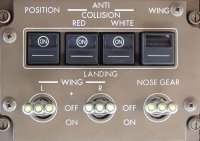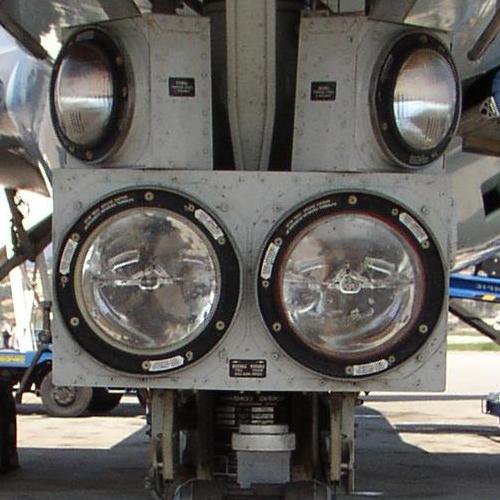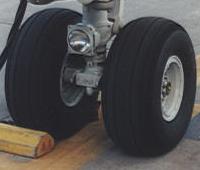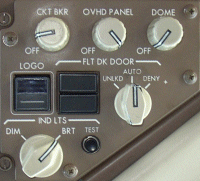Airplane General - Lighting
Lighting systems include:
Exterior Lighting

Exterior lighting consists of these lights:
Landing Lights
 The landing lights consist of the left, right and nose gear landing lights. The left and right landing lights are located in the left and right wing root and are optimised for flare and ground roll. The two nose gear-located landing lights are optimised for approach.
The landing lights consist of the left, right and nose gear landing lights. The left and right landing lights are located in the left and right wing root and are optimised for flare and ground roll. The two nose gear-located landing lights are optimised for approach.
The nose gear lights are inoperative when the nose landing gear is not down and locked.
Runway Turnoff Lights
Two runway turnoff lights are mounted on the nose landing gear. They are inoperative when the nose landing gear is not down and locked.
White Anti-Collision Lights
The white anti-collision lights are strobe lights located on each wing tip.
Red Anti-Collision Lights
The red anti-collision lights are strobe lights located on the top and bottom of the fuselage.
Navigation (Position) Lights
The navigation lights are standard red (left forward wingtip), green (right forward wingtip) and white (aft tip of both wings) position lights.
Wing Lights
Wing lights are installed on the fuselage and illuminate the leading edge of the wing.
Logo Lights
Logo lights are located on the stabiliser to illuminate the logo on the vertical tail surface.
Taxi Light (-300)
 One taxi light is installed on the steerable portion of the nose landing gear. The light is inoperative when the nose landing gear is not down and locked.
One taxi light is installed on the steerable portion of the nose landing gear. The light is inoperative when the nose landing gear is not down and locked.
Service Lighting
Service lights are located in each wheel well, cargo compartment and various other work areas. Controls for these lights are located at the individual service areas.
Flight Deck Lighting
 Flight deck lighting is provided for panel illumination, area lighting and localised illumination. Flood lights and light plates provide panel illumination. Dome lights provide flight deck area lighting. Map lights, chart lights and utility lights provide localised illumination.
Flight deck lighting is provided for panel illumination, area lighting and localised illumination. Flood lights and light plates provide panel illumination. Dome lights provide flight deck area lighting. Map lights, chart lights and utility lights provide localised illumination.
Panel and flood lights illuminate the forward panels, glareshield and aisle stand panels. When the light override switch is ON, the forward flood lights, glareshield flood lights, dome lights, aisle stand flood lights and all illuminated annunciator lights illuminate at full brightness.
If normal electrical power is lost, the Standby magnetic compass light, forward panel flood lights and integral lights for essential instruments on the left forward, centre forward and overhead panels are automatically switched to the Standby AC Bus.
Indicator Lights
 Indicator light brightness can be set to DIM or BRT with the Indicator Lights Selector. The system automatically overrides the DIM position and illuminates the indicator lights full bright if the ambient flight deck light level increases to a preset crossover light value, as detected by system sensors located on the centre forward panel.
Indicator light brightness can be set to DIM or BRT with the Indicator Lights Selector. The system automatically overrides the DIM position and illuminates the indicator lights full bright if the ambient flight deck light level increases to a preset crossover light value, as detected by system sensors located on the centre forward panel.
Passenger Cabin Lighting
Passenger cabin lighting is provided by white incandescent and fluorescent lights. General cabin illumination is accomplished with ceiling, sidewall wash and night lights. These are supplemented by reading, closet, attendant work, galley and lavatory lights. Lights are distributed over forward, mid and aft zones with controls located at the appropriate flight attendant panel.
Bright threshold entry lights, for passenger boarding, illuminate when the entry door is opened, and are inhibited when the door is closed.
The ceiling light, located just aft of the flight deck door, automatically extinguishes when the flight deck door is opened.